Essential Container Gardening Basics
I remember the day I turned my tiny apartment balcony into a green oasis. With just a few containers and a little creativity, I discovered the magic of container gardening. Learning the container gardening basics opened up a whole new world of possibilities, perfect for city dwellers and anyone with limited space.
Container gardening lets you grow plants in the most unexpected places. Whether you have a small balcony, a sunny windowsill, or a compact patio, understanding the container gardening basics will help you transform any space into a lush, productive garden.
With container gardening, you’re not limited by traditional garden boundaries. You can grow everything from juicy tomatoes to fragrant herbs in simple containers. It’s a fun, flexible, and rewarding way to bring nature into your home, no matter your experience level.
Key Takeaways
- Container gardening works in small spaces like balconies and windowsills
- Most vegetables, herbs, and flowers can thrive in containers
- No yard? No problem – container gardening is perfect for apartments
- Requires minimal investment and tools to get started
- Offers greater control over soil quality and plant conditions
Understanding Container Gardening Basics
Container gardening lets you grow plants in small, urban spaces. It’s a fun way to garden outside of traditional plots. This guide will introduce you to the world of container gardening.
What is Container Gardening?
Container gardening means growing plants in containers, not in the ground. You can garden almost anywhere – from balconies to big patios. It’s all about picking the right containers, soil, and plants.
Benefits of Growing in Containers
- Maximize limited urban space
- Control growing conditions precisely
- Easily move plants to optimize sunlight
- Manage soil quality more effectively
People love container gardening for its flexibility. You can grow many types of plants, like:
- Vegetables
- Annual and perennial flowers
- Herbs
- Ornamental shrubs
- Small trees
Common Container Types
Choosing the right container is key for good gardening. Each material has its own benefits:
| Container Type | Pros | Best For |
|---|---|---|
| Plastic Pots | Lightweight, affordable | Herbs, small flowers |
| Ceramic Containers | Decorative, heavy | Ornamental plants |
| Fabric Pots | Excellent drainage, breathable | Vegetables, root crops |
Pro tip: Make sure your containers have holes for drainage. This helps prevent root rot and keeps plants healthy.
Choosing the Right Location for Your Container Garden

Finding the right spot for your container garden is key to its success. The location can greatly affect your plants’ growth and health. You want to create a spot where plants can grow well with little stress.
When planning your container garden, consider these key location factors:
- Sunlight Exposure: Most vegetables and flowering plants need 6 to 8 hours of direct sunlight daily
- Water Accessibility: Make sure your garden is close to a water source for easy watering
- Wind Protection: Protect containers from strong winds that can harm delicate plants
- Temperature Considerations: Use the USDA Plant Hardiness Zone map to understand your specific climate zone
Different plants have different light needs. Vegetables and herbs usually need full sun, while some ornamental plants prefer partial shade. Make sure to position containers based on your plants’ specific needs.
Microclimates are important in container gardening. Areas near walls, patios, or structures can have unique temperature and light conditions. These spots might offer extra warmth or protection, making them great for sensitive plants.
Pro tip: Group plants with similar light and water needs together for optimal growth and easier maintenance.
Remember, container gardening is flexible. You can always move your containers to find the perfect spot as you learn more about your plants’ specific requirements.
Essential Container and Soil Requirements
Starting a container-garden is all about choosing the right container and soil. As a beginner, knowing these basics is key to your plants’ health and growth.

Success in container gardening depends on three main things: container size, drainage, and soil mix. The right mix ensures your plants thrive.
Container Size Guidelines
Vegetables need room to grow well. Here are some size tips:
- Small containers (10-12 inches): Best for 3-4 compact plants
- Medium containers (14-16 inches): Suitable for 5-7 plants
- Large containers (16-20 inches): Can accommodate 6-9 plants
Drainage Requirements
Good drainage stops root rot and keeps plants healthy. Experts say containers should have at least one hole for water to drain.
Soil Mix Selection
Picking the right soil is crucial. Don’t use garden soil, as it’s too heavy and can carry diseases. Instead, choose a light, nutrient-rich potting mix:
- Recommended composition: Mix of peat, perlite, and vermiculite
- Fill containers two-thirds full with all-purpose potting mix
- Choose specialized mixes for specific plants (e.g., ericaceous soil for acid-loving plants)
Container gardening is about creating a perfect mini-ecosystem for your plants to grow!
Selecting Plants for Container Growing
Urban gardening fans can turn small areas into lively green spots with the right container gardening. Choose plants that grow well in tight spaces. Dwarf veggies like cherry tomatoes, peppers, and bush beans are great for small gardens. They need little room but give big yields.
Knowing how deep your plants need to be is key. Use 4-5 inch containers for herbs like basil and chives. For veggies like carrots, peppers, and spinach, go for 8-9 inch containers. Think about how much sun your space gets, as most veggies need 6 hours of direct sunlight.
Pairing plants wisely can boost your garden’s success. Try tomatoes with basil, beans with carrots, and lettuce with herbs. But avoid mixing tomatoes with potatoes or beans with onions. This way, you’ll have a lively, productive garden on your balcony or patio.
Container plants need regular care. Use good potting soil, make sure they drain well, and fertilize often. With the right plants and care, your container garden will be a rewarding spot for fresh produce.







